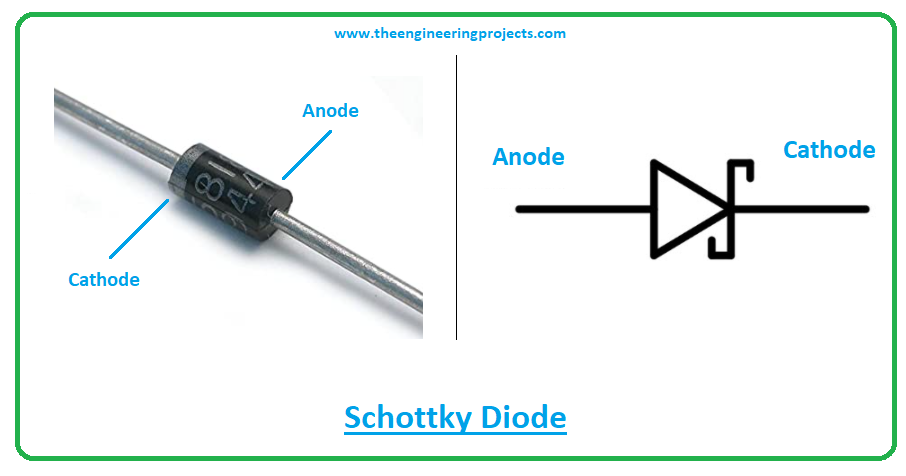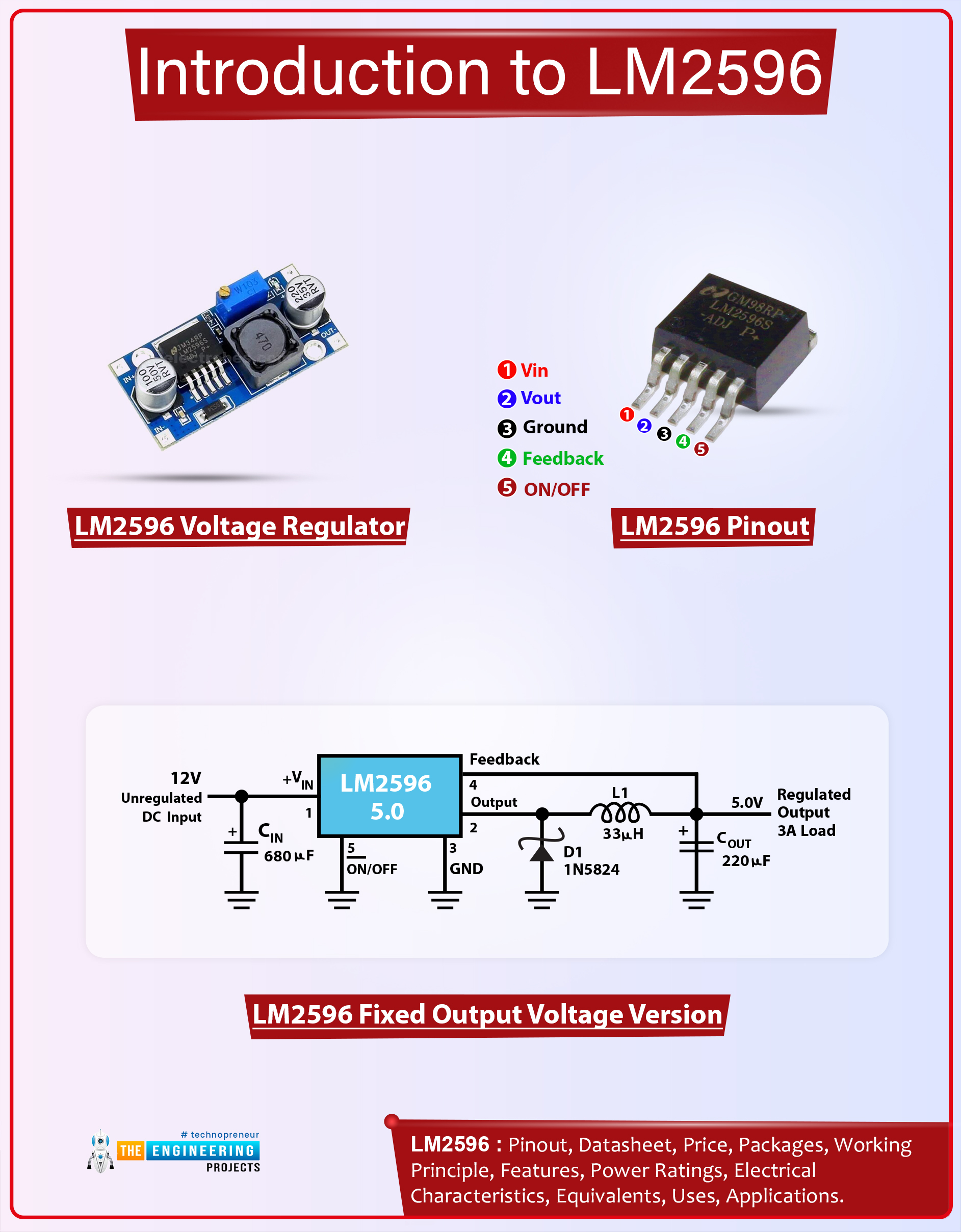

LM2596 Buck Converter Datasheet, Pinout, Features, Applications


Hi Guys! Welcome you on board. Happy to see you around. In this post today, I’ll detail the Introduction to LM2596.
LM2596 is a step-down voltage regulator, also known as a buck converter, mainly used to step down the voltage or to drive load under 3A. It carries remarkable load and line regulation and is available in fixed output voltages including 3.3V, 5V, and 12V. It also comes with a customized output version where you can set the output voltage as per your requirement.
Just stay with me for a little while, as in this post I’ll walk you through the Introduction to LM2596 covering the datasheet, pinout, features, and main applications of this tiny device. Let’s jump right in.
Introduction to LM2596
- LM2596 is a voltage regulator mainly used to step down the voltage or to drive load under 3A.
- It is also known as a DC-to-DC power converter or buck converter which is used to step down the voltage from its input supply to the output load. The current goes up during this voltage step-down process.
- LM2596 comes with a remarkable load and line regulation. It is available in both versions: fixed output voltage version with 3.3V, 5V, 12V, and customized output version where you can choose the output as per your requirement.

- This regulator is incorporated with a fixed-frequency oscillator and an internal frequency compensation method.
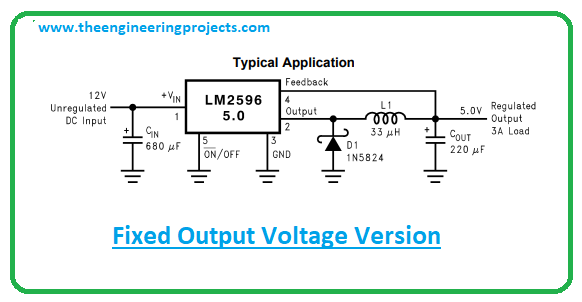
- Frequency compensation is applied by adjusting both phase and gain characteristics of the open-loop output to avoid oscillation and vibration in the circuit. This is achieved with the help of resistance-capacitance networks.
- A minimum number of external components is required for this regulator that works at a fixed frequency of 150 kHz.
- It is available in surface mount package TO-263 and standard 5-pin package TO-220.
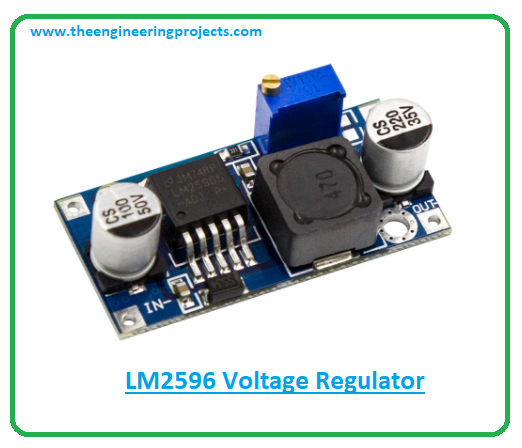
LM2596 Datasheet
Before you use this device for your electrical project, it’s wise to have a look at its datasheet which gives you an overview of the main characteristics of the component.
Click below to download the datasheet of LM2596.
LM2596 Pinout
The following figure shows the pinout diagram of LM2596.
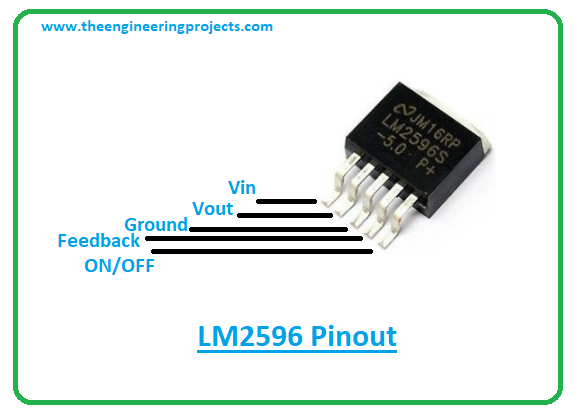
The LM2596 comes with a total of five pins as follows:
Vin = I = This is the input supply pin interlaced with the input bypass capacitor to provide the switching current and reduce voltage transients.
Output = O = This is the internal switch with voltage switches between (Vin – Vsat) and -0.5V. It comes with a duty cycle of Vout/Vin. The PCB copper area attached to this pin is used to minimize the coupling.
Ground = This pin is connected to the ground.
Feedback = I = This pin identifies the regulated output voltage for the feedback loop.
ON/OFF = I = This pin is used to shut down the voltage regulator circuit with the input supply current reducing to 80uA. When the voltage on this pin goes below the threshold voltage of 1.3V, it turns on the buck converter. And when the voltage goes above the 1.3V, it turns off the converter. You can get rid of this shutdown feature by attaching the pin to the ground or leaving it open. In both cases, the regulator remains ON.
LM2596 Features
- Fixed versions i.e. 3.3-V, 5-V, 12-V, and customizable output versions
- Customizable output version with voltage range: 1.2-V to 37-V ±4% maximum over load and line conditions
- Available in two packages including TO-263 and TO-220 packages.
- Can drive load under 3A.
- 40 V is the input voltage range
- 4 external components are needed
- Remarkable load and line regulations
- Internal oscillator with a fixed frequency of 150 kHz
- TTL shutdown capability
- Comes with low power standby mode, commonly 80 µA
- High efficient and readily available
- Protection against thermal shutdown and current
LM2596 Power Ratings
- The following table represents the absolute maximum ratings of regulator LM2596.
| Absolute Maximum Ratings LM2596 | ||||
|---|---|---|---|---|
| No. | Rating | Value | Unit | |
| 1 | Maximum Supply Voltage | 45 | V | |
| 2 | SD/SS Input Voltage | 6 | V | |
| 3 | Delay Pin Voltage | 1.5 | V | |
| 4 | Flag Pin Voltage | 45 | V | |
| 5 | Feedback Pin Voltage | 25 | V | |
| 6 | Output Voltage to Ground | -1 | V | |
| 7 | Storage Temperature | -65 to 150 | C | |
- While working with this component, make sure stresses don’t exceed the absolute maximum ratings, else they can permanently damage the component.
- Plus, if stresses are applied for more than the required time, they can affect device reliability.
LM2596 Applications
- Used to step down voltage
- Can drive load under 3A
- Provide remarkable load and line regulation
That’s all for today. I hope you find this read helpful. If you’re unsure or have any questions, you can leave your query in the section below, I’d love to help you the best way I can. You’re most welcome to share your feedback and suggestions, they help us create quality content. Thank you for reading the article.








 1 user
1 user






 Continue Wishlist
Continue Wishlist





 Getting Started Guide
Getting Started Guide
 Help Center
Help Center
 Contact us
Contact us
 Doist Blog
Doist Blog
 Privacy
Privacy
 Security
Security
 Terms of Service
Terms of Service
 What's new: Channel Descriptions
What's new: Channel Descriptions





 Electronic Components
Electronic Components jameswilson
jameswilson 0 Comments
0 Comments








 2.3k
2.3k
 953
953
 921
921
 2.1K
2.1K
 Introduction to LM2596
LM2596 pinout
LM2596 power ratings
LM2596 applications
Introduction to LM2596
LM2596 pinout
LM2596 power ratings
LM2596 applications
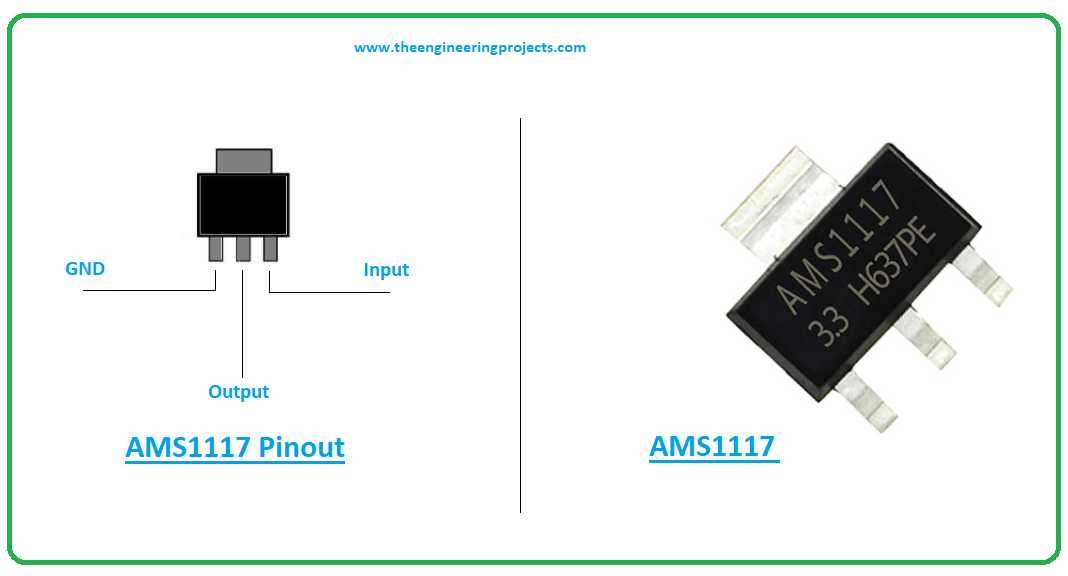
 Sunday, September 27, 2020
Sunday, September 27, 2020